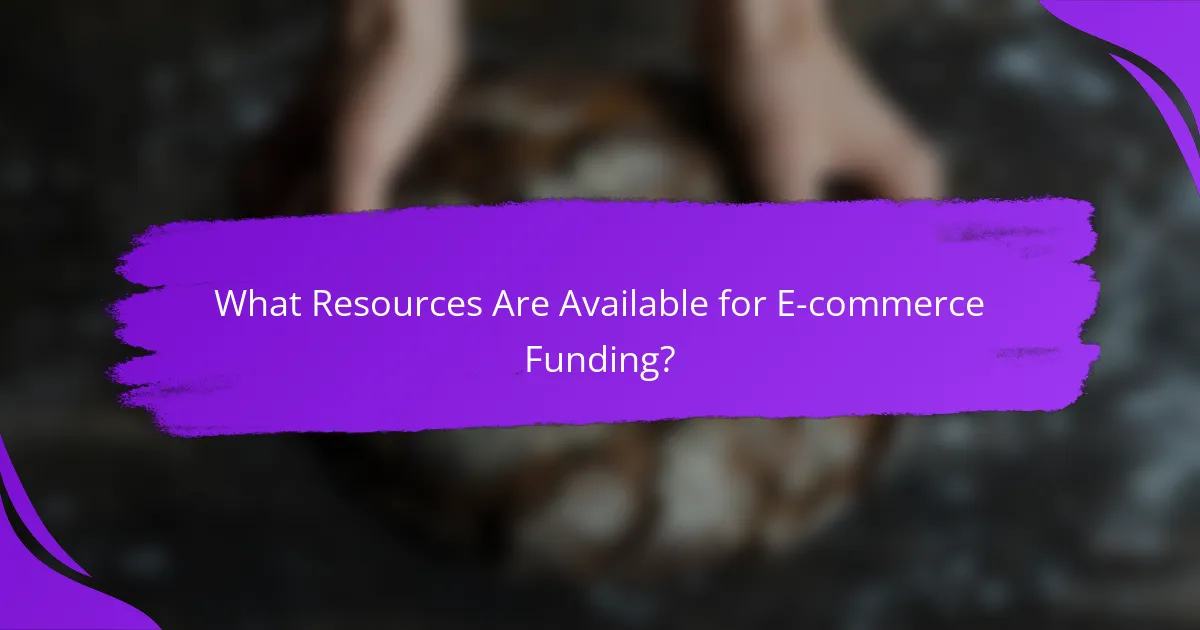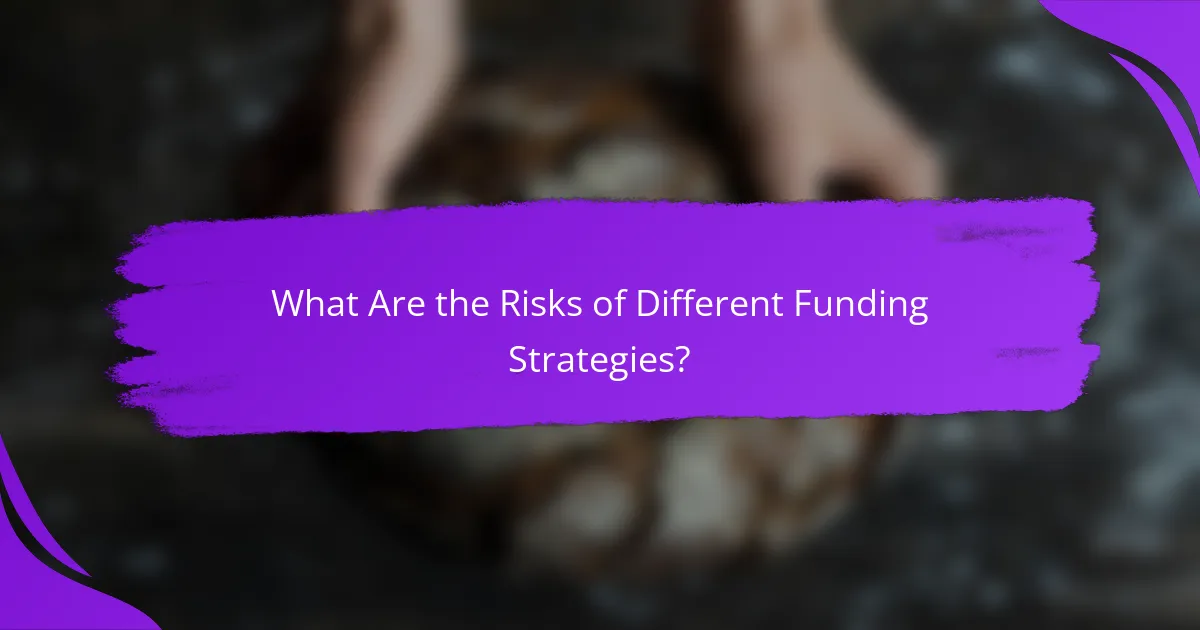In the competitive landscape of e-commerce, developing effective funding strategies is crucial for business growth and sustainability. By exploring diverse resources and aligning financial practices with eco-friendly initiatives, businesses can attract investors while enhancing their brand reputation. Understanding the advantages and challenges of various funding methods will empower entrepreneurs to make informed decisions that drive campaign success.

What Are Effective Funding Strategies for E-commerce?
Effective funding strategies for e-commerce involve various methods to secure capital for business growth. These strategies range from self-funding to seeking external investors, each with unique advantages and challenges.
Bootstrapping
Bootstrapping means funding your e-commerce business using personal savings or revenue generated from sales. This approach allows for complete control over the business without incurring debt or giving away equity.
While it can be a slow process, it encourages careful financial management and sustainable growth. Start by minimizing expenses and reinvesting profits to scale gradually.
Crowdfunding
Crowdfunding involves raising small amounts of money from a large number of people, typically via online platforms. This method can validate your business idea while building a community of supporters.
Consider platforms like Kickstarter or Indiegogo, where you can offer rewards or pre-orders in exchange for funding. Be prepared to market your campaign effectively to reach your funding goals.
Angel Investors
Angel investors are wealthy individuals who provide capital in exchange for equity or convertible debt. They often bring valuable experience and networks to help your e-commerce business grow.
To attract angel investors, create a solid business plan and demonstrate potential for high returns. Networking events and online platforms can help you connect with potential investors.
Venture Capital
Venture capital involves investment from firms that specialize in funding startups with high growth potential. This method typically requires giving up a significant portion of equity and is suitable for businesses aiming for rapid expansion.
Prepare for rigorous due diligence and be ready to present a scalable business model. Venture capitalists often seek a clear exit strategy, such as an acquisition or IPO, within a few years.
Grants and Competitions
Grants and competitions provide funding without the need to repay or give equity. Various organizations, including government agencies and private foundations, offer grants to support innovative e-commerce projects.
Research available grants in your region and apply for competitions that align with your business goals. Pay attention to eligibility requirements and deadlines to maximize your chances of success.

How Can Sustainability Be Integrated into Funding?
Sustainability can be integrated into funding by aligning financial strategies with eco-friendly practices and long-term environmental goals. This approach not only attracts socially conscious investors but also enhances brand reputation and operational efficiency.
Eco-friendly Business Practices
Implementing eco-friendly business practices involves adopting strategies that reduce environmental impact while maintaining profitability. Companies can start by minimizing waste, using renewable energy sources, and optimizing resource usage. For instance, switching to energy-efficient lighting can lower utility costs and reduce carbon footprints.
Additionally, businesses should consider adopting a circular economy model, where products are designed for reuse and recycling. This not only conserves resources but can also open up new revenue streams through resale or refurbishment.
Sustainable Supply Chain Management
Sustainable supply chain management focuses on sourcing materials and services that are environmentally responsible. This includes selecting suppliers who prioritize sustainability and ensuring that logistics operations minimize carbon emissions. Companies can evaluate suppliers based on their sustainability practices and certifications.
To enhance sustainability in the supply chain, businesses can implement strategies such as local sourcing, which reduces transportation emissions, and using eco-friendly packaging materials. Regular audits of the supply chain can help identify areas for improvement and ensure compliance with sustainability goals.
Green Certifications
Obtaining green certifications can enhance a company’s credibility and attract funding from environmentally conscious investors. Certifications such as LEED for buildings or ISO 14001 for environmental management systems provide a framework for sustainable practices and demonstrate commitment to environmental stewardship.
When pursuing certifications, organizations should prepare for the associated costs and time investment. However, the long-term benefits, including increased marketability and potential tax incentives, often outweigh these initial challenges. Companies should also promote their certifications in marketing materials to highlight their sustainability efforts.

What Resources Are Available for E-commerce Funding?
Various resources exist for e-commerce funding, including online platforms, government programs, and financial institutions. Each option has unique benefits and considerations that can significantly impact your business’s financial strategy.
Online Funding Platforms
Online funding platforms provide a convenient way for e-commerce businesses to access capital. These platforms typically allow entrepreneurs to present their business ideas to a broad audience of potential investors or lenders.
Popular options include crowdfunding sites like Kickstarter and Indiegogo, which enable businesses to raise funds by pre-selling products or offering rewards. Peer-to-peer lending platforms, such as LendingClub, connect borrowers directly with individual investors, often resulting in lower interest rates compared to traditional loans.
Government Programs
Government programs can offer substantial financial support for e-commerce businesses, often through grants or low-interest loans. These programs may vary by country and region, so it’s essential to research local options.
In the U.S., the Small Business Administration (SBA) provides various funding avenues, including the 7(a) loan program, which is designed for small businesses. In Europe, the European Investment Bank (EIB) offers funding initiatives that support innovation and digitalization in e-commerce.
Financial Institutions
Traditional financial institutions, such as banks and credit unions, are another key resource for e-commerce funding. They typically offer business loans, lines of credit, and merchant cash advances, which can be tailored to meet specific business needs.
When seeking funding from these institutions, prepare a solid business plan and financial projections to demonstrate your e-commerce business’s potential. Be aware that approval processes can be lengthy, and interest rates may vary widely based on your creditworthiness and the type of financing sought.

How to Measure Campaign Success in Funding?
Measuring campaign success in funding involves evaluating specific metrics that indicate how effectively resources have been utilized to achieve financial goals. Key metrics such as KPIs, ROI, and CAC provide insights into the efficiency and impact of funding strategies.
Key Performance Indicators (KPIs)
Key Performance Indicators (KPIs) are quantifiable measures that help assess the success of a funding campaign. Common KPIs include total funds raised, number of donors, and engagement rates. These metrics allow organizations to track progress and make data-driven decisions.
When selecting KPIs, focus on those that align with your campaign objectives. For instance, if your goal is to increase donor retention, measure the percentage of repeat donors over time. Regularly reviewing these indicators helps identify trends and areas for improvement.
Return on Investment (ROI)
Return on Investment (ROI) evaluates the financial return generated from funding campaigns relative to the costs incurred. To calculate ROI, subtract the total costs from the total revenue generated, then divide by the total costs and multiply by 100 to get a percentage. A positive ROI indicates a successful campaign.
Consider setting a target ROI based on industry benchmarks. For many non-profits, a ROI of 3:1 or higher is often considered successful. Regularly assessing ROI helps organizations understand the financial effectiveness of their campaigns and adjust strategies accordingly.
Customer Acquisition Cost (CAC)
Customer Acquisition Cost (CAC) measures the total cost associated with acquiring a new donor or supporter. This includes marketing expenses, outreach efforts, and any other costs incurred to bring in new funds. A lower CAC indicates a more efficient funding campaign.
To calculate CAC, divide the total costs of acquiring new donors by the number of new donors gained during a specific period. Aim for a CAC that is sustainable relative to the lifetime value of a donor. Monitoring CAC helps organizations optimize their fundraising strategies and allocate resources effectively.

What Are the Risks of Different Funding Strategies?
Different funding strategies carry various risks that can impact sustainability and campaign success. Understanding these risks is crucial for organizations to make informed decisions about which funding sources to pursue and how to manage them effectively.
Debt Financing Risks
Debt financing involves borrowing funds that must be repaid with interest, which can strain an organization’s cash flow. If revenue does not meet projections, organizations may struggle to meet repayment obligations, leading to financial distress.
Organizations should consider the interest rates and repayment terms before committing to debt. A common guideline is to ensure that debt repayments do not exceed a certain percentage of projected income, often around 20-30% for nonprofits.
Equity Financing Risks
Equity financing entails selling ownership stakes in the organization, which can dilute control for existing stakeholders. This strategy may attract investors who expect significant returns, potentially shifting the organization’s mission focus.
Organizations should weigh the benefits of immediate capital against the long-term implications of sharing ownership. It is essential to align investor expectations with the organization’s goals to avoid mission drift.
Grant Funding Risks
Grant funding can be highly competitive and often comes with strict reporting requirements and restrictions on how funds can be used. Organizations may find themselves dependent on grants, which can be unpredictable and subject to changes in government or foundation priorities.
To mitigate these risks, organizations should diversify their funding sources and build relationships with multiple grantors. Establishing a solid track record of successful grant management can enhance future funding opportunities.
Crowdfunding Risks
Crowdfunding relies on public support, which can be volatile and difficult to predict. Campaigns may fail to reach their funding goals, leading to wasted resources and potential reputational damage.
To increase the chances of success, organizations should set realistic funding targets and promote campaigns effectively. Engaging with the community and providing clear, compelling narratives can help attract backers.
Self-Funding Risks
Self-funding, or using personal or organizational reserves, can jeopardize financial stability if not managed carefully. This strategy may limit growth opportunities and create pressure to generate immediate returns.
Organizations should assess their financial health before opting for self-funding. Maintaining a reserve fund for emergencies or unexpected expenses is advisable to safeguard against potential risks.


